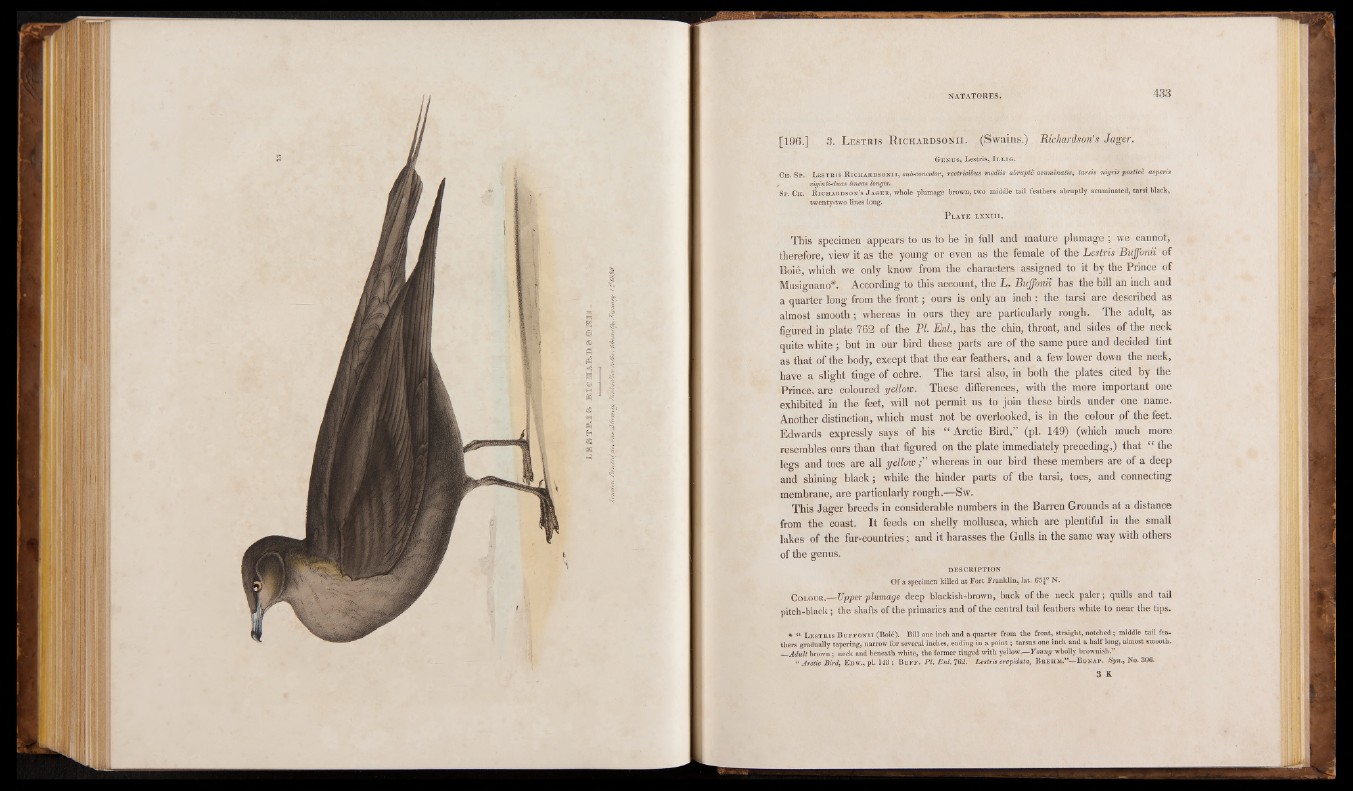
[196.] 3. L e s t r is R ic h a r d s o n ii. (Swains.) . Richardson’s Jager.
Ge n u s , Lestris, I l l ig .
Ch . Sp. L e s t r is R ic h a r d s o n ii, sub-concolor, rectricibus mediis abrupte aciminatis, tarsis nigrisposticl asperis
viginti-duas lineas longis. ■
Sp. Ch. Richardson’s J ager, whole plumage brown, two middle tail feathers abruptly acuminated, tarsi black,
twenty-two lines long.
P late l x x iii.
This specimen appears to us to be in full and mature plumage ; we cannot,
therefore, view it as the young or even as the female of the Lestris Buffonii of
Boie, which we only know from the characters assigned to it by the Prince of
Musignano*. According to this account, the L . Buffonii has the bill an inch and
a quarter long from the front; ours is only an inch : the tarsi are described as
almost smooth ; whereas in ours they are particularly rough. The adult, as
figured in plate 762 of the PI. Enl., has the chin, throat, and sides of the neck
quite white; but in our bird these parts are of the same pure and decided tint
as that of the body, except that the ear feathers, and a few lower down the neck,
have a slight tinge of ochre. The tarsi also, in both the plates cited by the
Prince, are coloured yellow. These differences, with the more important one
exhibited in the feet, will not permit us to join these birds under one name.
Another distinction, which must not be overlooked, is in the colour pf the feet.
Edwards expressly says of his “ Arctic Bird,” (pi. 149) (which much more
resembles ours than that figured on the plate immediately preceding,) that “ the
legs and toes are all y e l l o w whereas in our bird these members are of a deep
and shining black; while the hinder parts of the tarsi, toes, and connecting
membrane, are particularly rough.—Sw.
This Jager breeds in considerable numbers in the Barren Grounds at a distance
from the coast. It feeds on shelly mollusca, which are plentiful in the small
lakes of the fur-countries; and it harasses the Gulls in the same way with others
of the genus.
DESCRIPTION
Of a specimen killed at Fort Franklin, lat. 6 5 N.
C olour.— Upper plumage deep blackish-brown, back of the neck paler; quills and tail
pitch-black; the shafts of the primaries and of the central tail feathers white to near the tips.
* “ Le s t r is B u f f o n ii (Boi6). Bill one inch and a quarter from the front, straight, notched; middle tail feathers
gradually tapering, narrow for several inches, ending in a point; tarsus one inch and a half long, almost smooth.
__Adult brown; neck and beneath white, the former tinged with yellow.—Young wholly brownish.”
“ Arctic Bird, Edw., pi. 148 ; B u f f . PI. Enl. 762. Lestris crepidata, B r e h m .”—B o na p. Sgn., No. 306.
3 K